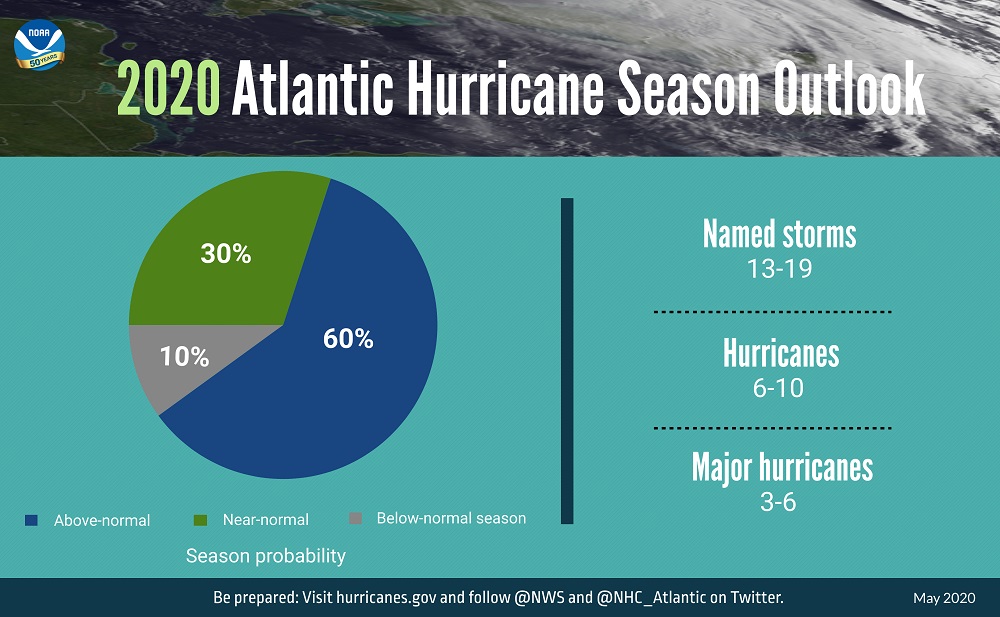NOAA forecasters predicting an active 2020 hurricane season are refining storm track and intensity forecasts thanks to data from multiple satellites, including the second Constellation Observing System for Meteorology, Ionosphere and Climate (COSMIC-2).
Six COSMIC-2 satellites launched in June 2019 aboard a SpaceX Falcon Heavy rocket are gathering more than 4,000 daily radio occultation soundings.
The soundings reveal moisture content at various altitudes “and moisture is one of the important ingredients for driving hurricanes,” said Jim Yoe, chief administrative officer for NOAA’s Joint Center for Satellite Data Assimilation, a multiagency research organization housed in the University Corporation for Atmospheric Research (UCAR) in Boulder, Colorado. Forecasters also rely on the atmospheric moisture data to determine a hurricane’s potential to produce heavy rainfall, he added.
For the hurricane season, which officially began June 1, NOAA upgraded its Hurricane Weather Research and Forecasting computer model. The new model ingests data from Geostationary Operational Environmental Satellites-16 and -17 in addition to pulling in data from NOAA-20, the NOAA-NASA SuomiNPP satellite, Japan’s Himawari-8 satellite, European Metop spacecraft and COSMIC-2.
With all the new data, “we expect to have improvements on the order of five percent for the track and perhaps as much as eight percent for the intensity of hurricanes in the North Atlantic and the Pacific basins,” Yoe said. “Because we’ve always done better at forecasting the tracks of hurricanes, there’s more room to improve our intensity forecasting.”
The upgrade comes at a critical time. Forecasters are acutely aware that the hurricane season is beginning during the COVID-19 pandemic. Moving people out of a hurricane’s path could be complicated by their desire to minimize unnecessary physical contact with anyone who could expose them to COVID-19.
“We always feel a huge responsibility to make the best forecast that we can in hurricane season,” Yoe said. “That’s especially true this year.”
NOAA’s Climate Prediction Center in College Park, Maryland, forecast six to 10 hurricanes with winds of at least 74 miles per hour during the 2020 season, which runs from June 1 through Nov. 30. Three to six of the storms are likely to produce winds of at least 111 miles per hour, making them major hurricanes, according to a May 21 NOAA news release. Hurricane seasons produce an average of six hurricanes, including three major hurricanes.
NOAA officials began feeding data from COSMIC-2 into forecast models in late May. Unlike the original COSMIC program, which included six satellites launched in 2006 into orbits widely dispersed around the globe, COSMIC-2 satellites are concentrated around the equator. The United States and Taiwan, which back the COSMIC programs through a joint venture, canceled plans in 2017 to build and launch another six polar-orbiting COSMIC-2 satellites, citing budget constraints.
To make up for that loss, NOAA is considering obtaining radio occultation data for polar regions from international and commercial satellite operators to feed future forecast models.
GeoOptics, PlanetIQ and Spire Global already supply radio occultation data to NOAA through the Commercial Weather Data Pilot. However, the radio occultation soundings the agency receives through the pilot program are not fed into operational weather models. Instead, NOAA conducts a retrospective analysis to determine whether the data would have improved forecasts if the agency had immediate access.
That type of retrospective analysis also underscores the contribution of radio occultation soundings to hurricane forecasts.
“Numerical studies have shown that we are nowhere near the saturation point for radio occultation data,” Yoe said. “We can add a lot more and still get measurable improvement to our forecast.”
At the American Meteorological Society conference in Boston in January, Steve Volz, NOAA assistant administrator for satellite and information services, said the agency has a target of acquiring 20,000 soundings per day.
“I would agree that we definitely want to continue increasing the number of radio occultation soundings that we have available to us,” Yoe said. “Having a compliment in high latitudes that’s comparable to what we have at low latitudes from COSMIC-2 is definitely desirable.”
If the soundings are destined for operational weather models, though, they need to be delivered very quickly. Setting up that speedy data delivery mechanism for new partners can be costly, Yoe said.
UCAR, the entity responsible for processing and disseminating COSMIC-2 data, is required to deliver COSMIC-2 observations to NOAA forecasters within 45 minutes.
This article originally appeared in the June 15, 2020 issue of SpaceNews magazine.
